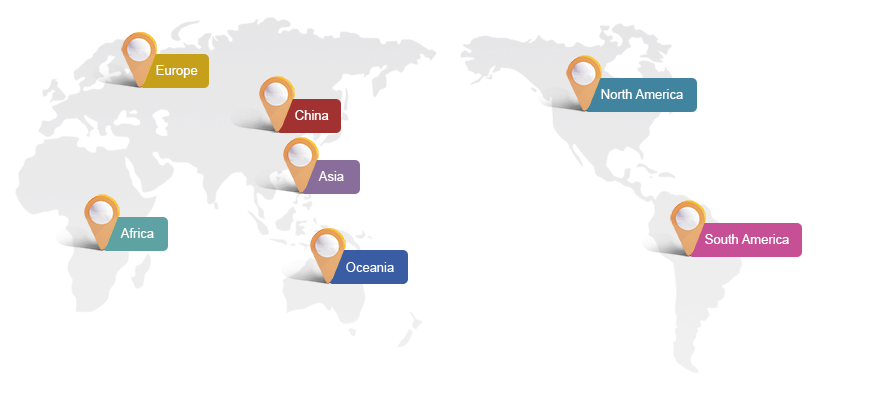General discription
Silicon carbide is a resistance type heating element.and made from high density reaction-bonded silicon carbide or high purity recrystallized silicon carbide , that are extruded in the form of rods or tubes, before being bonded together by a process of re crystallization, at temperatures of over 2500°C (4530°F). The firing process ensures the creation of rods with strong uniform bonds between adjacent grains, and the particle size distribution is closely controlled to ensure optimum density and resistance to the process atmosphere.
Heating elements for element temperatures up to 1625°C (2927°F), available in a wide variety of standard sizes and geometries, or in customized designs to meet the specific needs of various processes and equipment. heating elements are capable of high power output, and may be mounted either vertically or horizontally. no special supports are required.
Grade 1 QS1
SiC heating Elements suitable for most applications in which silicon carbide elements are used. heating elements feature hot zones of high purity recrystallized silicon carbide, optimized for resistance to oxidation and common process gases.
Grade2 QS2
SiC heating elements designed for the most challenging applications where conventional silicon carbide elements are unsuitable. SiC heating elements feature hot zones of high density, low permeability, reaction-bonded silicon carbide, which is highly resistant to oxidation, and to chemical attack by process volatiles and reactive atmospheres. At 2.7 g/cm3, this high-density low-porosity element has an extremely slow aging characteristic..
QS W TYPE float glass heating elements performers in float glass production,W TYPE heating elements are comprised of high purity, high density, silicon carbide grains, self bonded through recrystallization at elevated temperatures. Sintering at temperatures in excess of 2200ºC provides a structural density of 2.7grams per cubic centimeter. Such high structural density results in elements of maximum strength and minimum porosity, with an extremely slow aging characteristic.
Strength of the elements is further enhanced by insertion of hot zones into oversized cold ends. .cold end is manufactured of high resistance Alpha silicon carbide impregnated with silicon metal. It increases in resistance with an increase in temperature Silicon carbide heating elements designed to be utilized in float baths for the manufacture of soda-lime flat glass for architectural, automotive and solar-glass applications. TYPE W float glass elements have recorded campaign lengths up to 18 years.
OPERATING TEMPERATURES
SLIOCON CARBIDE HEATING ELEMENT USE BY ATMOSPHERE |
ATMOSPHERES | TEMPERATURE LIMIT | MXXIMUM LOADING W/in2 | MXXIMUM LOADING W/cm2 | EFFECT |
CLEAN DRY AIR | 1150℃ | Maximum | Maximum | One piece Sic element can be operated at furnace control temperatures up to 1600ºC. (Maximum element temperature is 1625ºC). The three-piece Sic element is limited to 1427ºC. |
HYDROGEN
DP+75°F
DP-60°F | 1300℃
1300℃
1093℃ | 30
30
30 | 5
5
5 | An atmosphere which contains any percentage of hydrogen whatsoever will react with silicon carbide if the temperature exceeds 1300ºC. |
AMMONIA | 1300℃ | 30 | 5 | Reduces silica film, Frorm CH4 from Sic |
NITROGEN | 1370℃ | 30 | 5 | Form insulating Silicon Nitrides |
PURE OXYGEN | 1315℃ | 25 | 4 | Faster oxidization than in air. Use LMA infusion glaze cotated starbar elements, or type TW, SE,SER or SEU |
CO2 | 1500℃ | 25 | 4 | No effect,may deposit Carbon |
CO | 1540℃ | 25 | 4 | No effect |
ARGON/HELIUM | 1700℃ | Maximum | Maximum | No detrimental effect |
WATER DP 60°F
50°F
0 °F
-50 °F | 1095℃
1200℃
1370℃
1540℃ | 30
45
40
45 | 5
5.5
6.5
7 | Reacts with Sic to form Silicon Hydrates ,Use LMA infusion glaze coated Starbar elements, or type TW,SE,SER,or SEU. |
HALOGENS | 700℃ | 25 | 4 | Attacks Sic and SiO2 reducing |
HYDROCARBONS | 1315℃ | 20 | 3 | Hot spotting from C pick-up |
METHANE | 1315℃ | 20 | 3 | Hot spotting from C pick-up |
DRY EXOTHERMIC GAS | 1400℃ | Maximum | Maximum | Dependent on composition |
DRY ENDOTHERMIC GAS | 1250℃ | Maximum | Maximum | Dependent on composition |
VACUUM | 1205℃ | 25 | 4 | To 7 Microns -Below vaporizes Sic. Short term use only |
S and SO2 | 1315℃ | 25 | 4 | Attack Sic |
For atmospheres containing water vapor, alkali metal vapors, flux vapors, or oxygen enrichment, we recommend the use of QS3 glaze coated elements
Glazes and coatings
Special glazes and surface treatments have been developed which can extend element life in various operating conditions, particularly where chemical attack is a problem. Details of these will be provided on request.
QS offers a special coating for certain severe atmosphere applications.
QS1 Coating
This coating consists of a complex silicate glass specially formulated to provide a high degree of protection against chemical attack in atmospheres containing water vapor, alkaline metal vapors, flux vapors and in applications that utilize oxygen enrichment, including; non-ferrous metal melting and holding, glass melting and refining, brazing, sintering of powdered metal components, and pre-sintering of powders for lithium ion battery cells.
QS2 Coating
This coating is a silicon carbide/silica composite. It is applied in 2 parts, an organic based pretreatment followed by a mix of silicon carbide and colloidal silica. The coating is cured to provide an adherent coating that covers the outside surface of the heating element. The organic portion burns away during the cure step to leave SiC and SiO2. This coating acts as a physical barrier to chemical attack on the heating elements.
QS3 Coating
This coating is a zirconia/silica based coating. When applied to the hot zone, this coating acts as a physical barrier to attack. When applied to the cold ends, the coating prevents the elements from sticking to the furnace refractor
SERVICE LIFE
All silicon carbide elements increase in resistance during their life in operation, This characteristic of increasing in resistance is called aging. Aging is a function of the following:
•Furnace temperature
•Element surface loading in W/cm2
•Atmosphere surrounding the elements
•Mode of operation – continuous or intermittent
•Operating practices and power control methods used
•Operating and maintenance technique
As a general guide, QS SIC elements may increase in resistance at a rate of about 5 – 6% per 1000 hours operating continuously in clean air at a temperature of 1400°C ( and at about 3% per 1000 hours use at 1000°C . It should be noted that small changes in operating conditions can alter these rates considerably
INTERCHANGEABILITY
QS SIC are premier grade high performance silicon carbide elements, and we are the only high quality silicon carbide heating elements manufactured in theCHINA. Elements can also be manufactured in special sizes and resistance values to replace elements supplied by other manufacturers in Asia and Europe. It is important to provide the nominal electrical resistance when ordering Sic elements.
EASE OF REPLACEMENT
SIC element can be replaced while the furnace is at operating temperature. The power to the elements being changed should be shut off, the spring clips and aluminum braid released, and the old SIC removed. The new SIC should be inserted smoothly through the hot furnace with sufficient speed to insure that the aluminum is not melted off the terminal end but not so fast as to cause thermal shock
AVAILABILITY
SIC can be shipped from stock, or two to three weeks after receipt of an order. In an emergency we may be able to produce more quickly.
CUSTOM CONFIGURATIONS
Special sizes and shapes are available. Cold ends can be different lengths. This, for example, would be applicable for furnaces with arched roofs that require longer cold ends through the roof and shorter through the floor. Another modification is a multiple-temperature hot zone. This, for example, would be helpful to get additional heat energy into the lower, more densely loaded tunnel kiln. While this special modified hot zone may not create a specific temperature differential, it does offer a convenient way to get more or less heat energy.
SUPERIOR PERFORMANCE
SIC elements will give you superior performance due to their high density -- approximately 2.52 g/cm3 .or 2.7 g/cm3to2.8 g/cm3 ,This gives the SIC elements very slow aging characteristics and high strength.
Ordering
The minimum information required when ordering QS SIC elements is as follows:
Element type:
Diameter, mm (ØA):
Hot zone length, mm(L):
Overall length, mm (L):
Nominal resistance,( Ω):




